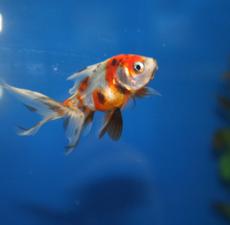
Shubunkin Goldfish
Overview: Shubunkins (朱文金) (Translated literally as "red brocade") are a hardy, single-tailed fancy goldfish with nacreous scales, and a pattern known as calico. The shubunkin are similar to the common goldfish and comet goldfish in appearance.
Native Range: Japan
Max. Length: 1 ft. +
Water: 66-90° F, pH 6.8-7.2
Feeding: Herbivore
Behavior & Care: The Shubunkin Goldfish is usually kept in ponds, but you can keep a Shubunkin Goldfish in an aquarium as well as long as you can provide it with enough space.
|
|

Ryukin Calico Goldfish
Overview: The Calico Ryukin is animated with a palette of red, orange, and black markings against a field of pearl white. This splendid color variation has an artistic, painted quality that makes each Calico Ryukin a unique piece of living art. The Calico Ryukin, like all Ryukin goldfish, has a prominent arch or hump immediately behind the head. A curved backbone, a fat belly, long feathery fins, a pointed mouth, and a triangular body shape are other features that differentiate the Ryukin from other goldfish varieties.
Native Range: Asia; china, japan
Max. Length: 8 inches
Water: 65-75° F, KH 4-20, pH 6.5-7.5
Feeding: Omnivore
Behavior & Care: As a member of the carp family, the Calico Ryukin is generally quite hardy. They will do well in 30 gallon aquariums or larger, as well as backyard garden ponds of 180 gallons or more. In addition to a fine gravel bottom or well-rounded river rocks, the Calico Ryukin will appreciate hardy, cold water plants. Keep in mind that goldfish are diggers and will scatter the fine sand onto leaves, injuring thin and less hardy plants.
|
|

Black Moor Goldfish
Overview: The black moor is a telescope-eyed variety of fancy goldfish that has a characteristic pair of protruding eyes. It is also referred to as popeye, telescope, kuro demekin in Japan, and dragon-eye in China.
Native Range: China & Japan
Max. Length: 10 inches
Water: 65-75° F, KH 4-20, pH 6.5-7.5
Feeding: Omnivore
Behavior & Care: The Black Moor Goldfish will thrive in a 30 gallon or larger tanks with a fine gravel bottom and hardy plants, it is known as plant eater so it is recommended to use only hardy plants such as Echinodorus species, Microsorium and Anubias species. When we decorate its tank we should think of its sensitive eyes and protect them from sharp decoration. The Black Moor gets along with other fish in a coldwater community fish tank and if kept with other goldfish it will school with them.
|
|
  
Telescope Butterfly Goldfish
Overview: The Telescope Goldfish is also known as the Dragon Eye Goldfish and Celestial Eye Goldfish. The most stunning feature of this fish is the large protruding eyes resembling those of a dragon. They have long been considered as the most representative goldfish of China. The Telescope Goldfish is available in many interesting colors, including the Red/White, Calico, and Red Telescope.
Native Range: Asia, China, Japan
Max. Length: 8 inches
Water: 65-75° F, KH 4-20, pH 6.5-7.5
Feeding: Omnivore
Behavior & Care: All goldfish are members of the carp group and are generally quite hardy. The Telescope Goldfish will do well in a 30 gallon or larger tank with a fine gravel bottom and hardy, cold water plants. Goldfish are diggers and will scatter the fine sand onto leaves, injuring thin and less hardy plants. Roots and well-rounded river rocks are a good addition to the aquarium. |
|
  
Oranda Goldfish
Overview: The Oranda Goldfish is one of the most popular goldfish in the world. It is favored for its hood, a fleshy growth on the top of its head called the wen.
Native Range: Asia; Central Asia (siberia)
Max. Length: 6 - 7 inches
Water: 65 - 72° F
Feeding: Omnivore
Behavior & Care: Oranda Goldfish are very popular and are found in collectors tanks throughout the world. But although they are widely available, they are considered delicate and not recommended as a beginner fish.
|
|

Fantail Goldfish
Overview: Fantail Goldfish are recognized by their medium sized double/split tail fins. You can judge the breeding quality of a Fantail goldfish by looking at how far their fins are split. The tailfin of a high quality Fantail goldfish is almost completely split down to the root.
Native Range: China, Japan
Max. Length: 6 inches
Water: pH: 6.0 - 9.0
Feeding: Omnivore
Behavior & Care: The fantail goldfish is a good choice for beginners since they are very hardy and due to the fact that Fantail goldfish can be kept in temperatures close to the freezing point. Fantail goldfish are also an ideal choice if you want to keep some type of fancy goldfish in garden ponds due to the earlier mentioned reasons.
|
|

Comet Goldfish
Overview: The comet or comet-tailed goldfish is the most common variety of fancy goldfish in the United States. It is similar to the common goldfish, except slightly smaller and slimmer, and is mainly distinguished by its long deeply forked tail.
Native Range: United States
Max. Length: 12 inches
Water: 65° - 78°F
Feeding: Omnivore
Behavior & Care: The Comet is more active than most other goldfish breeds. It is not unusual to see a Comet dashing back and forth in his tank, racing around in a playful manner. Due to the comet's hardy and active nature, and the relative ease in caring for them, they are the breed best suited to ponds and outdoor pools. |
|
| |
| |
| |
| |
| |